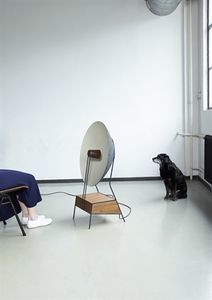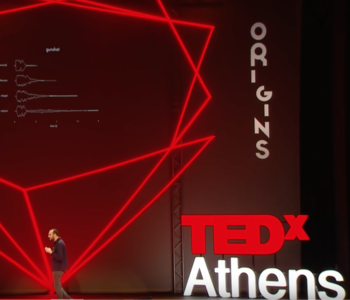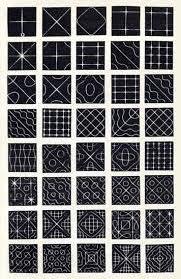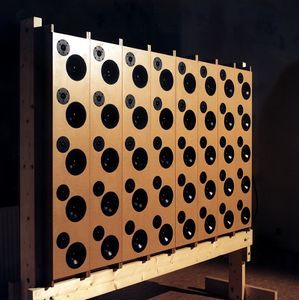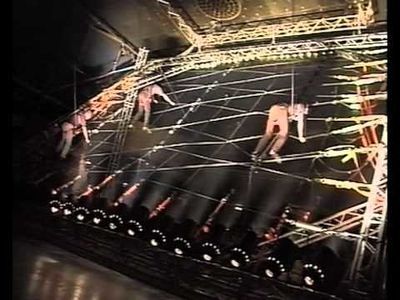Difference between revisions of "User:KvdH/MINOR FINAL PROJECT"
| (34 intermediate revisions by the same user not shown) | |||
| Line 1: | Line 1: | ||
= Question= | = Question= | ||
= Research= | = Research= | ||
| − | + | <gallery mode=packed width=200px heights=200px> | |
| + | File:Sanne_Geelissen.jpeg|'''Sound Scene | Sanne Gelissen''' <br> Open floor plans are easy on the eye, but work less well acoustically. One person wants to listen to music, while the other wants to read. We’ve all been there. What to do? Sanne Gelissen has an answer: ‘Sound Scene’. Instead of allowing sound to spill out and take over the entire room, this device bundles sound waves together, beaming them towards a specific point – like a kind of sound spotlight. Within this audio zone, music can be enjoyed to the max. Step outside, and it quickly fades to a minimum. The same space can be shared without a wall or room divider in sight. | ||
| − | + | File:TedTalk.png|'''The Beautiful Lies of Sound Design | Tasos Fratzolas | TEDxAthens''' From gunshots in a canyon to underwater submarine engines, this audio-rich talk explores the role of sound design in modern storytelling.Soundsnap.com founder Tasos Frantzolas looks at a variety of multimedia examples to show the ways that sound designers ‘lie’ in creating the sonic palette of film, television and interactive media. https://www.youtube.com/watch?v=jDy5j0c6TrU | |
| − | |||
| − | |||
| − | + | File:Chladni.jpeg|'''Chladni Patterns | Patterns in soundwaves''' Chladni Pattern is the nodal pattern formed on a plate when an external driving source is given to make the plate vibrate. Figure 1 is a demonstra- tion of how Chladni uses simple devices to visualize sound. On a horizontal plate he put some fine sand, and then give the plate a certain frequency of vibration at some point. As a response, all the points on the plate start to vibrate but each point vibrates with different amplitude. Particularly there are some points that always stand still. Therefore, the sand at the neigh- bourhood moves towards the ”silent” points, which is how the sand pattern is formed. For the same plate, the pattern varies with the frequency of the driving source. https://www.youtube.com/watch?v=1yaqUI4b974 | |
| − | |||
| − | |||
| − | |||
| − | |||
| + | File:Bls1.jpg|'''Edwin van der Heide''' is an artist and researcher in the field of sound, space and interaction. He extends the terms composition and musical language into spatial, interactive and interdisciplinary directions. His work comprises installations, performances and environments. The audience is placed in the middle of the work and challenged to actively explore, interact and relate themselves to the work. http://www.evdh.net | ||
| − | + | File:Sensorband.jpg|'''Sensorband''' is a trio of musicians using interactive technology. Gestural interfaces - ultrasound, infrared, and bioelectric sensors - become musical instruments. The group, Edwin van der Heide, Zbigniew Karkowski, Atau Tanaka, each soloists on their instruments for over six years, formed Sensorband to create a performance ensemble. Edwin plays the MIDIconductor, machines worn on his hands that send and receive ultrasound signals, measuring the hands' rotational positions of and relative distance. Zbigniew activates his instrument by the movement of his arms in the space around him. This cuts through invisible infrared beams mounted on a scaffolding structure. Atau plays the BioMuse, a system that tracks neural signals (EMG), translating electrical signals from the body into digital data. Together, Sensorband creates a live group dynamic, bringing a visceral physical element to interactive technologies. Sensorband's projects center around the theme of physicality and human control/discontrol in relation with technology.. http://www.evdh.net | |
| − | + | </gallery> | |
| − | |||
| − | |||
| − | |||
| − | |||
| − | |||
| − | |||
| − | |||
| − | |||
| − | |||
| − | < | ||
Latest revision as of 12:52, 15 November 2016
Question
Research
Sanne Gelissen
Open floor plans are easy on the eye, but work less well acoustically. One person wants to listen to music, while the other wants to read. We’ve all been there. What to do? Sanne Gelissen has an answer: ‘Sound Scene’. Instead of allowing sound to spill out and take over the entire room, this device bundles sound waves together, beaming them towards a specific point – like a kind of sound spotlight. Within this audio zone, music can be enjoyed to the max. Step outside, and it quickly fades to a minimum. The same space can be shared without a wall or room divider in sight.TEDxAthens From gunshots in a canyon to underwater submarine engines, this audio-rich talk explores the role of sound design in modern storytelling.Soundsnap.com founder Tasos Frantzolas looks at a variety of multimedia examples to show the ways that sound designers ‘lie’ in creating the sonic palette of film, television and interactive media. https://www.youtube.com/watch?v=jDy5j0c6TrU
Patterns in soundwaves Chladni Pattern is the nodal pattern formed on a plate when an external driving source is given to make the plate vibrate. Figure 1 is a demonstra- tion of how Chladni uses simple devices to visualize sound. On a horizontal plate he put some fine sand, and then give the plate a certain frequency of vibration at some point. As a response, all the points on the plate start to vibrate but each point vibrates with different amplitude. Particularly there are some points that always stand still. Therefore, the sand at the neigh- bourhood moves towards the ”silent” points, which is how the sand pattern is formed. For the same plate, the pattern varies with the frequency of the driving source. https://www.youtube.com/watch?v=1yaqUI4b974
Edwin van der Heide is an artist and researcher in the field of sound, space and interaction. He extends the terms composition and musical language into spatial, interactive and interdisciplinary directions. His work comprises installations, performances and environments. The audience is placed in the middle of the work and challenged to actively explore, interact and relate themselves to the work. http://www.evdh.net
Sensorband is a trio of musicians using interactive technology. Gestural interfaces - ultrasound, infrared, and bioelectric sensors - become musical instruments. The group, Edwin van der Heide, Zbigniew Karkowski, Atau Tanaka, each soloists on their instruments for over six years, formed Sensorband to create a performance ensemble. Edwin plays the MIDIconductor, machines worn on his hands that send and receive ultrasound signals, measuring the hands' rotational positions of and relative distance. Zbigniew activates his instrument by the movement of his arms in the space around him. This cuts through invisible infrared beams mounted on a scaffolding structure. Atau plays the BioMuse, a system that tracks neural signals (EMG), translating electrical signals from the body into digital data. Together, Sensorband creates a live group dynamic, bringing a visceral physical element to interactive technologies. Sensorband's projects center around the theme of physicality and human control/discontrol in relation with technology.. http://www.evdh.net
